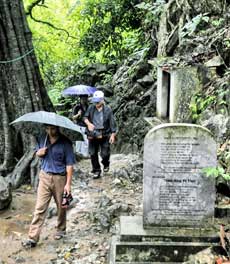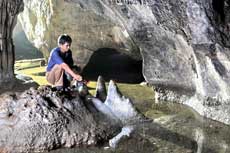Tu Thuc Cave, also known as Bich Dao Cave lies on Than Phu Mountain in Nga Thien Commune, Nga Son District of Thanh Hoa Province, about 50km northeast of Thanh Hoa City. It is a well-known area with a legend about Tu Thuc’s meeting with a fairy.

According to an old story, district chief Tu Thuc was a native in Tong Son District (present-day Ha Trung District, Thanh Hoa Province). Once, during his leisure time after resigning as a mandarin, Tu Thuc went to Than Phu seaport to relax. While passing a mountain he saw a beautiful cave and went in to look. He met Giang Huong in the cave and they became husband and wife. They lived a happy life in the fairytale cave. After a long time, he felt homesick and returned to his native place for a visit. Seeing that there were no longer familiar people or sights, he found out that he had been away for a very long time. Heavy-hearted, he went back to the cave but it was empty and his wife was not there.
The rocky path to Tu Thuc Cave is over 100m long, running from the foot of the mountain upwards. In front of the cave are lush trees and interlacing creepers. At the cave’s entrance there is a shrine worshipping the mountain god and on the high cliff there is a poem in Chinese script praising the beauty of Tu Thuc Cave composed by King Le Thanh Tong (1460-1497) and scholar Le Quy Don (1726-1784).

For a long time, people have enjoyed Tu Thuc Cave’s beauty and its mystery of the love story between Tu Thuc and Giang Huong.
The main cave consists of three parts. The outer part is large with a ceiling that looks like an upside down giant bowl. Hanging from the ceiling is a stalactite in the shape of a peach, thus the cave is also called Bich Dao. The floor is flat and has traces of the shrine dedicated to Tu Thuc. There are big stalagmites in different shapes and sizes which are named according to people’s imagination, such as cache of silver, cache of rice, cache of salt and cache of money.
Leaving the first part, visitors go through a narrow rock slit to reach the second part. Here, they see a stalagmite in the shape of the “Sacrifice of Three Animals†(ox, pig and goat). On the floor there is a layer of stalagmite that looks like a dragon lying curled up among hundreds of yellow egg-like stalagmites, so it is called the “Dragon hatching golden eggsâ€. Going deeper, visitors are more surprised by many stalactites and stalagmites in strange shapes which create a fairytale world relating to the romantic love story of Tu Thuc and Giang Huong. These include Tu Thuc’s study room, Giang Huong’s bathroom and dress, flowers, peaches, the moon, and a pair of stone birds.
After going through the second part of the cave, visitors walk along a small wooden bridge over a murmuring stream and reach the third part which is high, wide and sparkling like the hall of a large theatre. Here, there are many stalactites and stalagmites looking like paintings, a chessboard, a pair of shoes, flowery carpets, seals, costumes and hats. These evoke the activities of the district chief, Tu Thuc in the past.

Deep inside, there are two human footprints in the rock. Legend has it that these are Tu Thuc’s footsteps. Nearby, there is a pool of clear water, where, as legend says, Giang Huong showered and frolicked. Beside the pool there is a spotted green rock strip and a strip of rocks in the shape of frogs, which are considered to be the image of Tu Thuc’s homeland. There are two deep alleys, one heading to the sky and the other to the earth’s womb, which people call the ways to heaven and hell.
Looking down from the entrance of Tu Thuc Cave visitors see a vast peaceful space at the foot of the mountain with square fields resembling a chessboard, a winding river and a village hidden under green bamboo trees. They will think of the story about Tu Thuc who strayed into a fairytale place and one day felt homesick for his homeland.